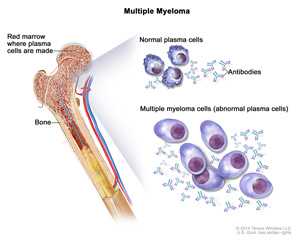Myeloma
Multiple myeloma cells are abnormal plasma cells (a type of white blood cell) that build up in the bone marrow and form tumors in many bones of the body. Click to see a larger diagram.
© 2014 Terese Winslow LLC, U.S. Govt. has certain rights. Used with Permission. Contact artist at www.teresewinslow.com for licensing.
Myeloma is a cancer of the plasma cells. In myeloma, the cells grow too much, forming a mass or tumor that is located in the bone marrow. Bone marrow is the spongy tissue found in the center of the bone, where red cells, white blood cells, and platelets are made. Multiple myeloma is the most common form of myeloma.
What Causes Myeloma?
Scientists don’t understand why some people get myeloma and others don’t. Age is the most significant risk factor for developing myeloma. People younger than 45 years old rarely develop the disease. Men are more likely than women to develop myeloma, and myeloma is more than twice as common among black people as among white people. In rare cases, exposure to X-rays or other kinds of ionizing radiation may be a risk factor for developing myeloma.
What Are the Symptoms of Myeloma?
Sometimes myeloma does not cause any symptoms. It may be found when a blood or urine test is done for another condition. Symptoms of myeloma may include bone pain, especially in the back or ribs; bones that break easily; fever for no known reason; frequent infections; bruising or bleeding easily; trouble breathing; weakness of the arms or legs; and feeling very tired.
These symptoms can also come from other conditions. If you have any of them, talk to your doctor.
Statistics
In the United States in 2014 (the most recent year for which numbers are available)—
- 23,555 people (13,190 men and 10,365 women) were diagnosed with myeloma.
- 12,112 people (6,589 men and 5,523 women) died from myeloma.
- Among men, black men had the highest rate of getting myeloma (15.0 per 100,000 men), followed by Hispanic† men (7.5), white men (7.2), American Indian/Alaska Native men (6.1), and Asian/Pacific Islander men (4.6).
- Among women, black women had the highest rate of getting myeloma (10.5 per 100,000 women), followed by Hispanic† women (5.2), white women (4.5), American Indian/Alaska Native women (4.2), and Asian/Pacific Islander women (3.1).
†Hispanic origin is not mutually exclusive from race categories (white, black, Asian/Pacific Islander, American Indian/Alaska Native).
Data source: U.S. Cancer Statistics Working Group. United States Cancer Statistics: 1999–2014 Incidence and Mortality Web-based Report. Atlanta (GA): Department of Health and Human Services, Centers for Disease Control and Prevention, and National Cancer Institute; 2017. Available at: http://www.cdc.gov/uscs.
More Information
- Multiple Myeloma/Other Plasma Cell Neoplasms (National Cancer Institute)
- Multiple Myeloma (Medline Plus)
- Myeloma (Leukemia & Lymphoma Society)
- What Is Multiple Myeloma (Multiple Myeloma Research Foundation)
- Multiple Myeloma (American Cancer Society)
- NCCN Guidelines for Patients: Multiple Myeloma (National Comprehensive Cancer Network)
- Page last reviewed: September 20, 2017
- Page last updated: September 20, 2017
- Content source:


 ShareCompartir
ShareCompartir
